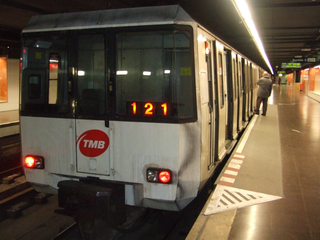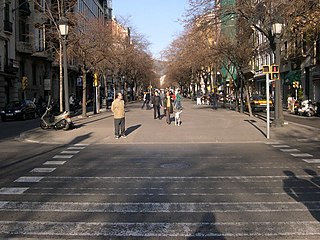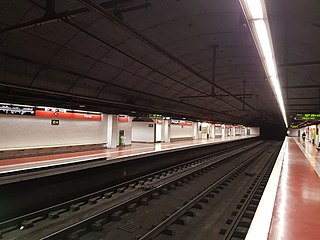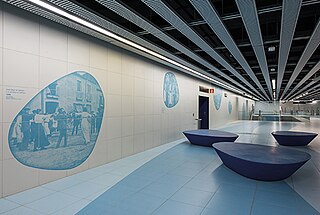
The Trambaix is one of Barcelona's three tram systems. It is operated by TRAMMET connecting the Baix Llobregat area with the city of Barcelona, Catalonia, Spain. It opened to the public on 5 April 2004 after a weekend when the tram could be used free of charge.

Line 1, shortened to L1, coloured red and often simply called Línia vermella, is the second oldest Barcelona Metro line, after line L3. It is the longest line of the Barcelona Metro, and links L'Hospitalet de Llobregat and Santa Coloma de Gramenet. Originally operated by the independent Ferrocarril Metropolitano Transversal de Barcelona, it is today operated by Transports Metropolitans de Barcelona (TMB) and is part of the ATM fare-integrated main transport system. L1 is the only metro line in Spain to use Iberian gauge tracks, as used by most Spanish main line railways.

Line 9 is a completely automated line of the Barcelona Metro network that is currently under construction, with 24 stations open in Barcelona and El Prat de Llobregat, L'Hospitalet de Llobregat, Badalona and Santa Coloma de Gramenet suburbs, since December 2009. The line is currently disconnected in two branches, with a connecting part between the two yet to be built. The Aeroport T1 – Zona Universitària section is called L9 South, and the La Sagrera – Can Zam portion L9 North. Upon completion, it will be the longest underground metro line in Europe.
— Line 8, coloured pink and operated by FGC, is part of the Barcelona Metro network, and therefore of the larger ATM fare-integrated transport system. It joins Plaça Espanya, in the Sants-Montjuïc district of Barcelona with metropolitan area municipalities of L'Hospitalet de Llobregat, Cornellà de Llobregat and Sant Boi de Llobregat.

Hospital de Bellvitge, formerly known as Feixa Llarga, is a Barcelona Metro station, in the L'Hospitalet de Llobregat municipality of the Barcelona metropolitan area, and named after the nearby Bellvitge University Hospital. The station is the western terminus of line L1.

Rambla de Catalunya is a major street in the Eixample district of central Barcelona, Spain. It is one of the city's trendiest streets, with many international fashion shops, and is lined with lime trees.

Plaça d'Espanya, also simply known as Espanya, is an interchange complex underneath Plaça d'Espanya, in the Barcelona district of Sants-Montjuïc, in Catalonia, Spain. It comprises the Barcelona terminus of the Llobregat–Anoia Line and a Barcelona Metro station complex served by lines 1 (L1) and 3 (L3). On the L1, the station is between Hostafrancs and Rocafort, and on the L3 it is between Poble Sec and Tarragona. The Llobregat–Anoia Line station is served by Barcelona Metro line 8 (L8), Baix Llobregat Metro lines S33, S4 and S8, and commuter rail lines R5, R6, R50 and R60. The services on the Llobregat–Anoia Line are operated by Ferrocarrils de la Generalitat de Catalunya (FGC), whilst the L1 and L3 are operated by Transports Metropolitans de Barcelona (TMB).

Can Boixeres is a station on line 5 of the Barcelona Metro.

Can Vidalet is a station on line 5 of the Barcelona Metro.
Europa | Fira is a railway and metro station on the Llobregat–Anoia Line. It is located underneath Gran Via de les Corts Catalanes, near Plaça d'Europa and Carrer d'Amadeu Torner, in the L'Hospitalet de Llobregat municipality, to the south-west of Barcelona, in Catalonia, Spain. Opened on 13 May 2007, it was due to be named Amadeu Torner, in reference to the street of the same name. The station can be accessed from both sidewalks of Gran Via, serving as a major public transport access to the Gran Via business center. It is served by Line 8, Line 9, Baix Llobregat Metro lines S33, S4 and S8, and commuter rail lines R5, R6, R50 and R60.

The Barcelona–Vallès Line is an unconnected standard gauge rapid transit and commuter railway line linking Barcelona with Sabadell and Terrassa via the Collserola mountain range, in Catalonia, Spain. Its name refers to the Catalan historical region of Vallès, whereby most part of the line runs. Plaça de Catalunya station serves as the Barcelona terminus of the line, where almost all its trains either start or terminate. The line then continues northwards and branches off twice before leaving the city limits. Its main route splits in two in Sant Cugat del Vallès, forming two major branches to Sabadell and Terrassa. It has 40 passenger stations in operation and a total line length of 48.1 kilometres (29.9 mi).

Bellvitge | Rambla Marina is a Barcelona Metro station, in the L'Hospitalet de Llobregat municipality of the Barcelona metropolitan area, and named after the nearby neighbourhood of Bellvitge. The station is served by line L1. It is some 750 metres (2,460 ft) west of Bellvitge railway station, served by Rodalies de Catalunya commuter and regional rail services.

Avinguda Carrilet, also known as L'Hospitalet Avinguda Carrilet, is an interchange complex underneath Avinguda Carrilet in the L'Hospitalet de Llobregat municipality, to the south-west of Barcelona, in Catalonia, Spain. It consists of a railway station on the Llobregat–Anoia Line and a Barcelona Metro line 1 (L1) station. The Llobregat–Anoia Line station is served by Barcelona Metro line 8 (L8), Baix Llobregat Metro lines S33, S4 and S8, and commuter rail lines R5, R6, R50 and R60. The services on the Llobregat–Anoia Line are operated by Ferrocarrils de la Generalitat de Catalunya (FGC), whilst the L1 is operated by Transports Metropolitans de Barcelona (TMB).

Can Serra is a Barcelona Metro station, in the L'Hospitalet de Llobregat municipality of the Barcelona metropolitan area, and named after the nearby Can Serra neighbourhood. The station is served by line L1.

Florida is a Barcelona Metro station, in the L'Hospitalet de Llobregat municipality of the Barcelona metropolitan area, and named after the nearby La Florida neighbourhood. The station is served by line L1.

Torrassa is a Barcelona Metro station, in the L'Hospitalet de Llobregat municipality of the Barcelona metropolitan area, and named after the nearby La Torrassa neighbourhood. The station is served by line L1, line L9 and line L10.
Sant Josep is a railway station on the Llobregat–Anoia Line. It is located underneath Avinguda Carrilet, between Carrer de Miquel Romeu and Carrer de Mestre Candi, in the L'Hospitalet de Llobregat municipality, to the south-west of Barcelona, in Catalonia, Spain. The current underground station was opened on 8 July 1985, replacing the original at-grade station dating of 1912. It is served by Barcelona Metro line 8, Baix Llobregat Metro lines S33, S4 and S8, and commuter rail lines R5, R6, R50 and R60.

Public transport in Cornellà de Llobregat is an important part of the transportation network spanning the Metropolitan Area of Barcelona. The city of Cornellà, a mostly working-class area with strong dormitory town traits, is one of the most populated in the Baix Llobregat with about 90,000 inhabitants and a daily destination for thousands of commuters in the urban area of the capital.

Fira, originally known as Fira 2 – Pedrosa, is a Barcelona Metro station serving Fira de Barcelona's Fira Gran Via major trade fair venue and the Pedrosa industrial park, in the L'Hospitalet de Llobregat municipality, to the south-west of Barcelona. It is situated underneath Avinguda Joan Carles I, at the intersection with Pedrosa and Botànica streets. It has a direct access to Fira Gran Via's main entrance. The station was designed by Japanese architect Toyo Ito.

Can Tries | Gornal is a Barcelona Metro station, in the L'Hospitalet de Llobregat municipality of the Barcelona metropolitan area, and named after the nearby Gornal neighbourhood. The station is served by line L9 and line L10.



















